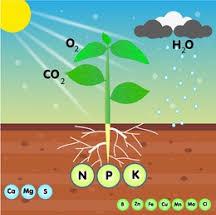MINERAL NUTRITION
Introduction
The process of absorption, translocation and assimilation of nutrients by the plants is called mineral nutrition. Here mineral nutrition refers inorganic plant nutrients.
Most of the minerals present in soil can enter plants through roots and therefore these are called mineral nutrients. The elements C, H, O are not minerals. Near about, more than sixty elements of the 105 discovered so far are found in different plants.

Criteria for Essentially
In 1939, D.I. Arnon and P.E. Stout proposed criteria of essentiality, later on it was refined by Arnon in 1954. Arnon and Stout concluded three criteria given below.
- The element must be absolutely necessary for supporting normal growth and reproduction. In the absence of the element the plants do not complete their vegetative and reproductive life cycle.
- The requirement of the element must be specific and not replaceable by another element. In other words, deficiency of any one element cannot be corrected by supplying some other element.
- The element must be directly involved in the nutrition and metabolism of the plant.
However, some investigation shows that the point (2) cannot be accepted absolutely as Molybdenum (Mo) may be substituted by vanadium (V), chlorine (Cl) by Bromine (Br), K by Rubidium (Rb) and Ca by Strontium (Sr).
Further, Arnon and Stout concluded only 16 essential nutrients for plants, but presently Nickel (Ni) is also considered as essential therefore, total essential nutrients are 17 in number.
Classification of Essential Nutrients
Based on above criteria, the essential elements are further divided into two broad categories based on their quantitative requirements.
- Macronutrients, and
- Micronutrients
Macro-nutrients
These are generally present in plant tissues in large amounts (in excess of 10 mmole Kg –1 of dry matter). The macronutrients include:
- Basic Nutrients (Carbon, Hydrogen, Oxygen)- These constitute about 96% of the total dry matter of plants. Among them C & O constitute 45% each. These are mainly obtained from CO2 and H2O.
- Primary or Major Nutrients (Nitrogen, Phosphorous, Potassium)- Such elements are required in larger amounts i.e., more than 1ppm
- Secondary Nutrients (Calcium, Magnesium and Sulphur)- These are called secondary because they are supplied indirectly to the soils with NPK fertilizers which contain these nutrients.
Primary & Secondary elements are absorbed from the soil as mineral nutrition.
Micro-nutrients or Trace Elements
These are needed in very small amounts, generally less than 1ppm. Such nutrients are also termed as oligonutrients or supurne elements and are very efficient can produce optimum effects even in minute quantities.
These include Iron, Manganese, Copper, Molybdenum, Zinc, Boron, Chlorine and Nickel.
Functional Nutrients
In addition to the 17 essential elements named above, there are some beneficial elements such as sodium, silicon, cobalt and vanadium. So, these are together with essential nutrients called functional nutrients. These are required by higher plants.
Beneficial Nutrients
Such elements at very low concentration and often under particular conditions observed that they stimulate the growth of certain plants e.g., Selenium (Se), Aluminium (Al), Rubidium (Rb), Sr, Cr (Chromium) and Arsenic (As).
Based on their diverse function-
Elements Major Role C, H, O Provide basic structure (structural elements of cell) C, H, O, N, P, S Tissue building elements K, Mg, Ca, Cl Electrolytic balance Ca, Mg, P Skeletal elements H, O Energy exchange elements N, P, S Energy storage, transfer & bonding Plastic and storage of energy Oxidation reduction regulators Cu, Fe, Mn, S Catalytic elements
Forms of elements absorbed by plants
Elements Ionic form Non-ionic form Source C CO32-, HCO3- CO2 mostly Air, Water H Molecular H2O Air, Water O Molecular H2O Air, Water N NO3-, NH4+ CO(NH2)2 amide Mostly from soil, Parts of N from air P H2PO4-, HPO42- Nucleic acid Phytin Soil K K+ Soil Ca Ca+ Soil Mg Mg2+ Soil S SO42- SO2 from air Soil and air Fe Fe3+, Fe2+ FeSO4 with EDTA Soil Mn Mn2+ MnSO4 with EDTA Soil Zn Zn2+ ZnSO4 with EDTA Soil Cu Cu2+ CuSO4 with EDTA Soil B B4O72-, H2BO3, HBO32-, BO33- Soil Mo MoO42-, HMO4- Soil Cl Cl- Soil Ni Ni2+ Soil Na Na+ Soil Co Co2+ Soil Si Si (OH)4- Soil
EDTA- Ethylene Diamine Tetracetic acid.
Read also…
ROLE OF ESSENTIAL PLANT NUTRIENTS
ESSENTIAL NUTRIENTS-DEFICIENCY SYMPTOMS